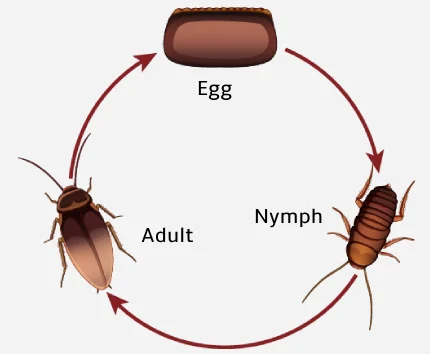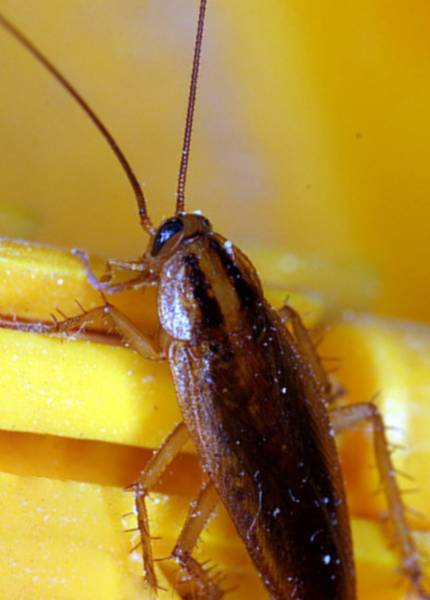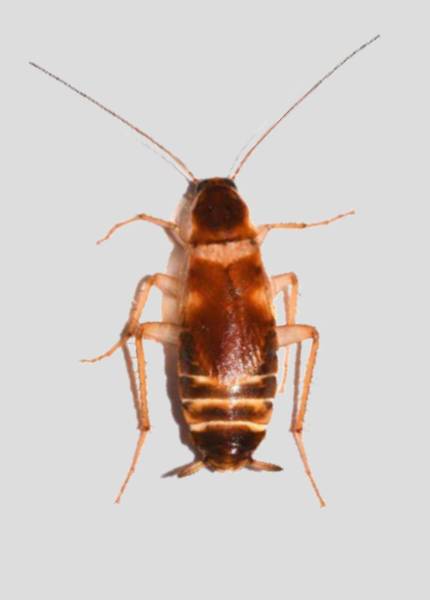Cockroach
Cockroach
Most cockroaches are tropical or sub-tropical in origin and generally live outdoors. However, some species have adapted well to living with humans. Though it is true that they prosper in clutter, filth and grime, cockroaches at times infest even the most sanitary and well-organized homes and buildings.
Cockroaches enter buildings in infested boxes, grocery bags, beverage cartons, furniture and dried pet foods. They also enter around loose-fitting doors and windows, where electrical lines or water and steam pipes pass through walls, in seasoned firewood and through sewer lines.
Most cockroaches are nocturnal and appear during daylight only when disturbed or where there is a heavy infestation. They prefer warm, dark, humid shelters, and often move around the kitchen sink or drainboard. They prefer to rest in cracks around, under or inside cupboards and cabinets; where pipes or electrical wiring pass along or through a wall; behind window or door frames, loose baseboards or molding strips; under tables and chairs; in upholstered furniture; in bathrooms; in radio and TV cabinets; and in motor compartments of refrigerators, washing machines and other appliances. It is important to know where cockroaches are hiding in your home because these are the locations that must be cleaned and treated.
Cockroaches feed on a variety of plant and animal products, including meat and grease, starchy foods, sweets, baked goods and other unprotected kitchen goods. They also feed on materials such as leather, wallpaper paste and book binding and sizing.
Cockroaches rank high on the homeowner’s list of pest problems. Their presence in the home is objectionable and implies uncleanliness. Cockroaches contaminate food with excrement and salivary secretions, and they may leave an unpleasant odour. Cockroaches also carry disease organisms, although their role in transmitting diseases to humans is poorly documented.



Biology and Behavior
Cockroaches develop by gradual metamorphosis and have three life stages: egg, nymph and adult. Adult females produce small, bean-shaped egg capsules. The female usually drops the egg capsules or glues them to some surface soon after they are formed. However, the female German cockroach carries the capsule protruding from her body until the eggs are ready to hatch. Nymphs hatch from the eggs and emerge from the capsules. They resemble adult cockroaches, except that they are smaller and do not have fully developed wings. Their flattened bodies and long, spiny legs enable them to run rapidly and to squeeze into crevices and other dark hiding places.
Nymphs molt several times before becoming mature males and females. The time required to complete the life cycle varies from about 2 months to nearly 3 years depending on the species, food and water sources, and environmental conditions.



Common Species
There are approximately 3,500 species of cockroaches. 4 type of cockroach species are troublesome in homes, cafés and other buildings. German Cockroach (Blattella germanica)
German Cockroach (Blattella germanica)
The adult German cockroach is light brown and 1/2 to 5/8 inch long. The head shield has two dark stripes which run lengthwise. Adults are fully winged but rarely fly. Nymphal German cockroaches are smaller and darker than adults and are wingless.
The German cockroach is the most prevalent cockroach in India and is more active than other domestic species., the German cockroach produces more eggs per capsule than most other species and has a developmental period as short as 2 months. Thus, troublesome infestations can develop rapidly from a few individuals.
This is the only domestic species in which adult females carry egg capsules protruding from their abdomens until the eggs are ready to hatch. In fact, few eggs will hatch if the capsule is detached from the female more than a day or two before hatching would normally take place.
These cockroaches thrive in all types of buildings but are found most often in homes, apartments, condominiums and commercial food establishments. They usually enter tightly constructed homes with bottled drink containers, potatoes, onions, dried pet foods, grocery sacks, corrugated cartons and even furniture. German cockroaches usually seek dark shelters near moisture and food, such as in kitchens and bathrooms. However, when populations become large and food is scarce, they appear in bedrooms and other less likely places.






Brownbanded Cockroach (Supella longipalpa)
The brown-banded cockroach is light gold to glossy dark brown and is 1/2 to 5/8 inch long. It has transverse yellow bands across the base of the wings and across the abdomen. The wings of adult males cover their abdomens, while the females’ wings are shorter. The yellow bands across the back are more pronounced on nymphs than on adults.
These cockroaches are quite active, and the adults, especially the males, fly rapidly when disturbed. Both adults and nymphs may jump to escape danger. The adult female carries her egg capsule for only a day or two before glueing it to a protected surface underneath or inside furniture, in a closet or on the ceiling in a darkened room. They can also be found in televisions and other appliances.
Brownbanded cockroaches are more apt to be found in homes, apartments, hotels, motels, nursing homes and hospitals than in restaurants, grocery stores and other commercial establishments. They prefer starchy foods and appear to have lower water requirements than other cockroaches. They can occupy drier locations within a building. Nymphs and adults frequently are found on ceilings in dark or dimly lit rooms, behind picture frames, in light switches, in upper walls of cabinets and closets, or on undersides of furniture and inside upholstered furniture. Because brown-bodied cockroaches are found in so many locations, they may be more difficult to control.
American Cockroach (Periplaneta americana)
American Cockroach (Periplaneta americana)
The American cockroach is the largest of the common species, growing to a length of 1 1/2 to 2 inches. It is reddish-brown with a light-yellow band around the edge of the head shield. Adults of both sexes have well-developed wings but seldom fly. They are, however, capable of gliding flights. Nymphal cockroaches are smaller than adults, greyish-brown in color and less fully winged.
The adult female usually drops her egg capsule within a day after it is formed. She often places the capsule near a food or water source or in a location where it can be covered with miscellaneous debris.



Oriental Cockroach (Blatta orientalis)
Adult oriental cockroaches are glossy dark brown to black. Females may be nearly 1 1/4 inches long, while males are 1 inch long. The male’s wings cover most of the body, while the female’s shorter wings are reduced to mere lobes. Neither sex can fly, and in fact, these cockroaches are rather sluggish and do not move very fast even when disturbed. Nymphal cockroaches are smaller than adults, dark brown to black, and have wing stubs without definite veins.
The adult female oriental cockroach usually carries her egg capsule for about a day, then drops it or attaches it to a protected surface near a food supply. These cockroaches appear to have a seasonal cycle in their development. They overwinter as large nymphs or adults and are usually noticed in the spring when they mate. In the spring of the year, they migrate from buildings to the out of doors where they spend the summer months. In the fall, the next generation tries to find shelter indoors where they can spend the winter. Natural mortality usually reduces the number of adults in the population during the summer, fall and winter.
Nymphs and adults are usually found near decaying organic matter. During warm, humid weather, they inhabit lawns, compost piles, flower beds and dumps. However, in periods of drought or with the approach of cold weather, they move in masses into homes and other buildings. In buildings, these cockroaches inhabit high-moisture areas such as sewers, drains and dark, damp basements. Their activities are somewhat restricted to the ground or below-ground levels of buildings.



Experience unparalleled cockroach control with Truly Dust, a safe yet highly effective solution. In our pest control for cockroaches, we use white powder which is safer than common salt and eradicates cockroaches without building immunity. Trust Truly Nolen India for cutting-edge, safe chemicals, ensuring your family’s safety and well-being. Contact us for more information about cockroach pest control.
Our Clients













Truly is present in more than 37 cities across the country, having more than 400 employees. TPS is currently serving 4000+ commercial and 10000+ residential clients, with an increasing list of clients on a daily basis.
- 915, Hemkunt Tower, 98 Nehru Place, New Delhi -110019.
© Truly Nolen 2023 . All Right Reserved. Designed By Verve Media.
